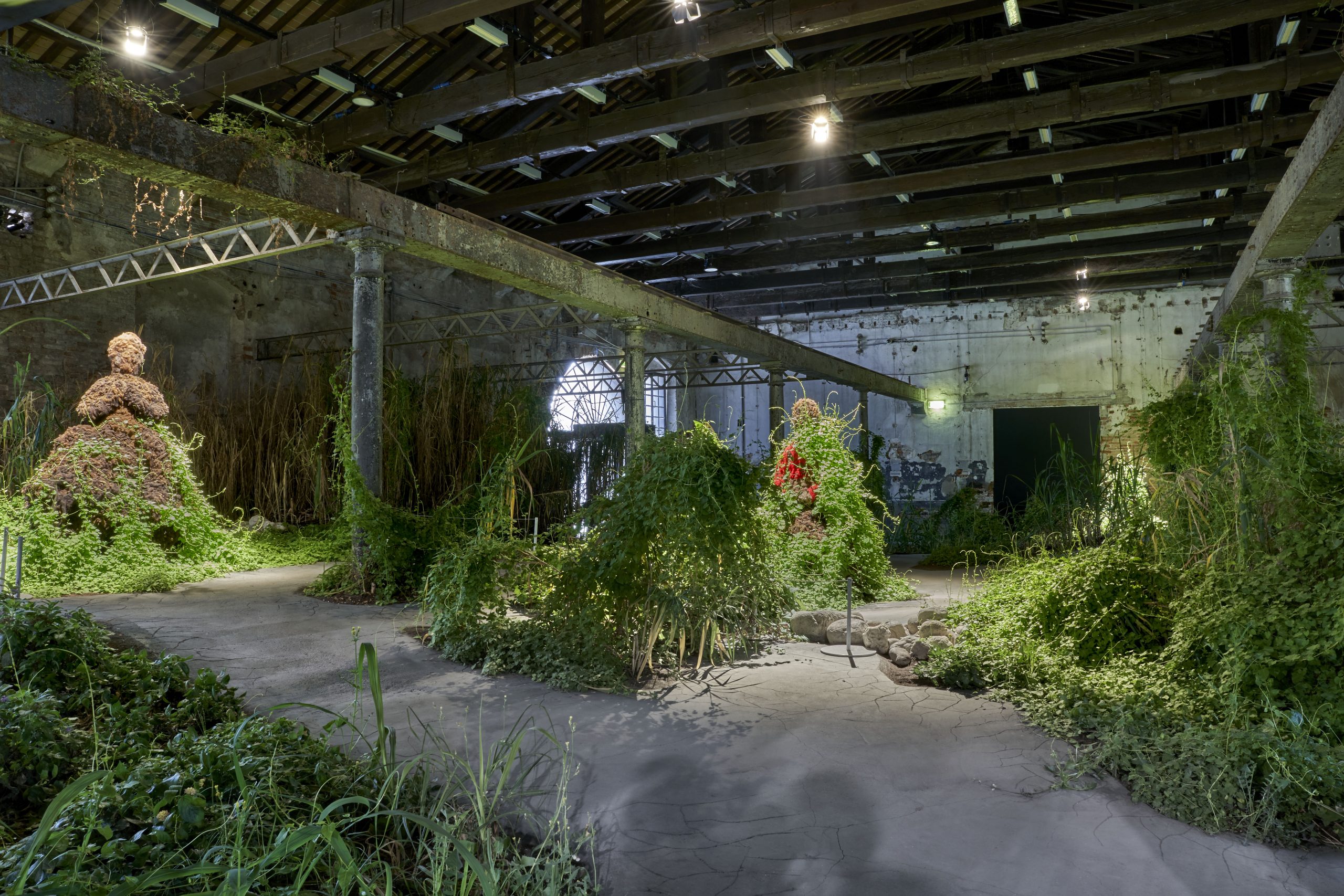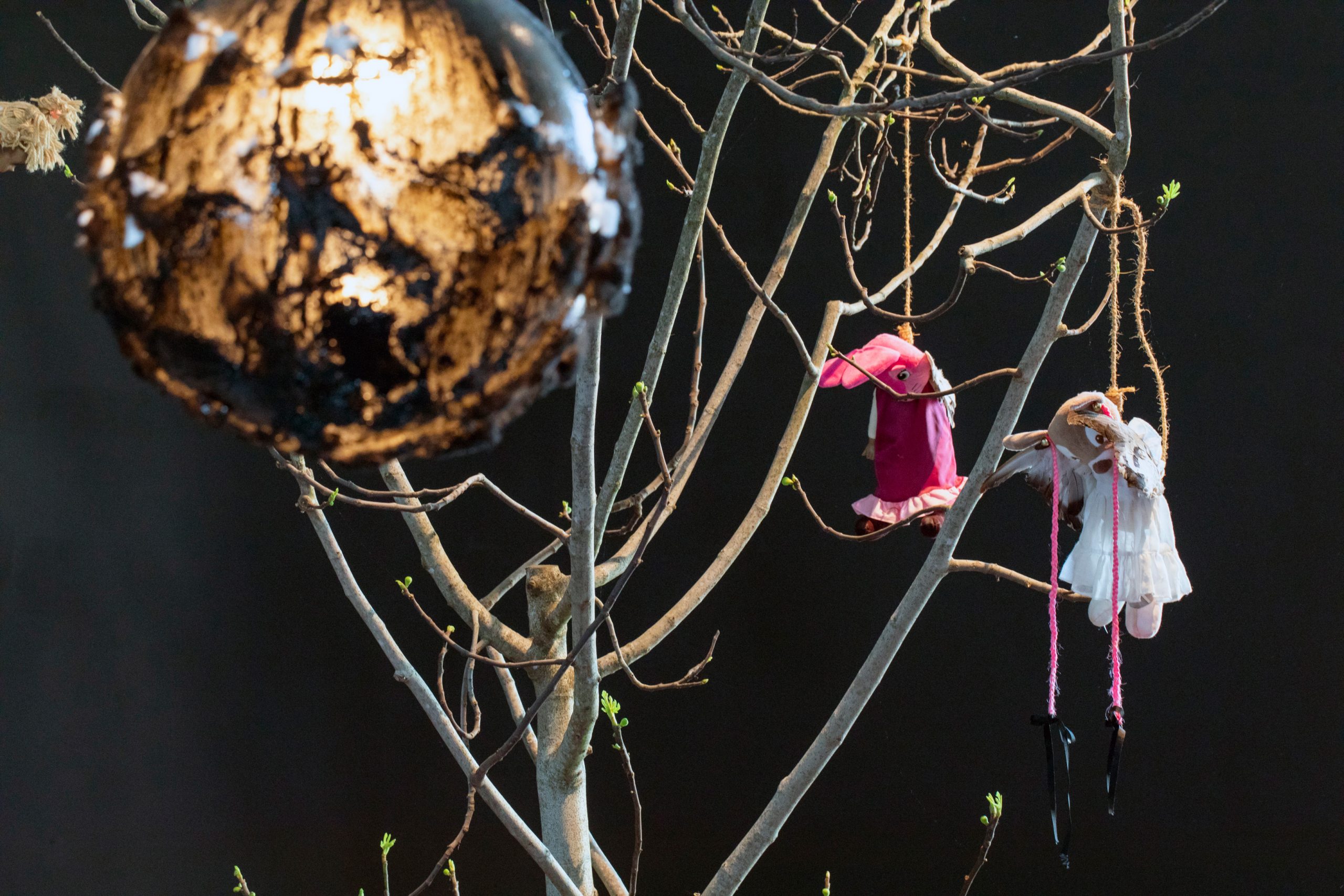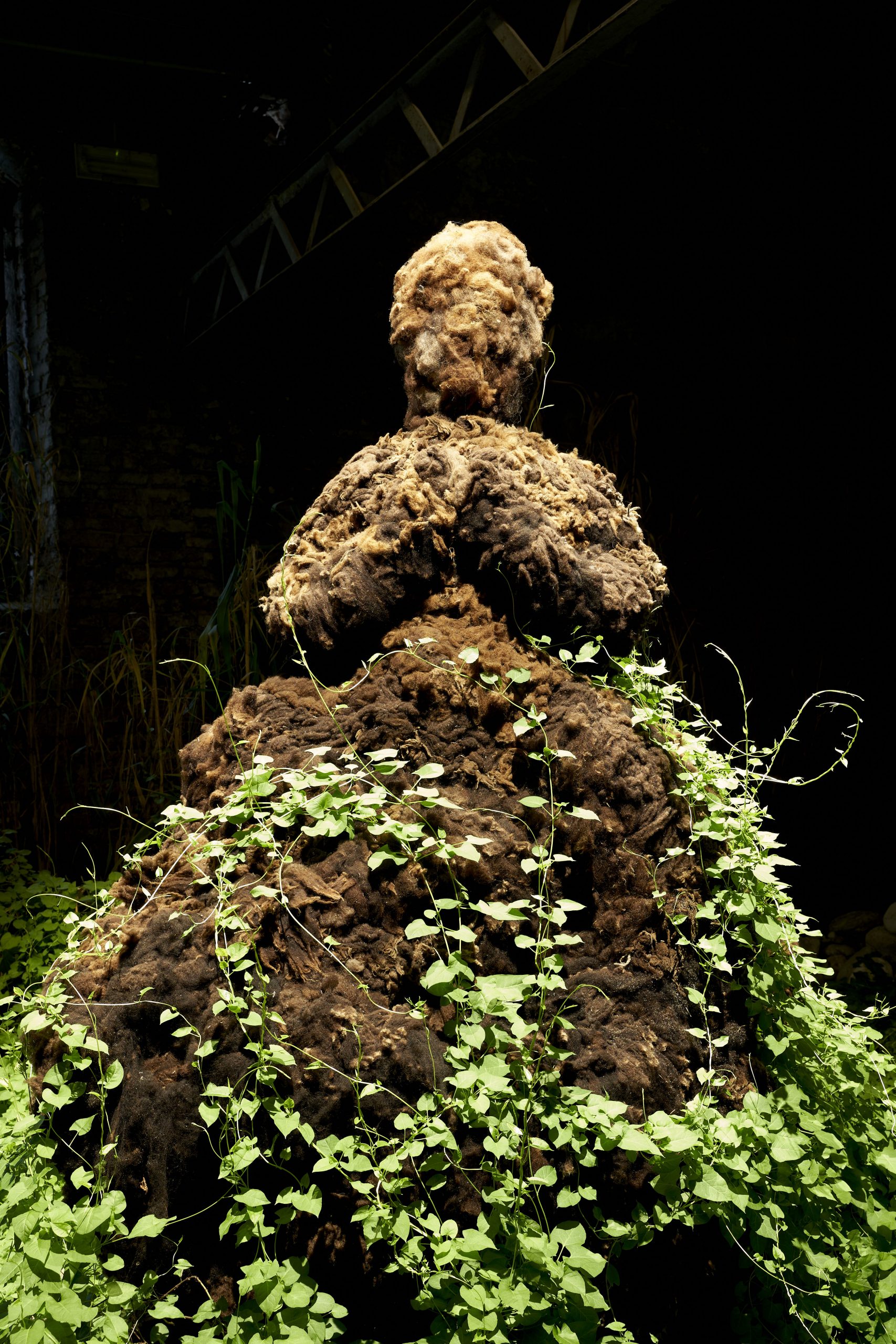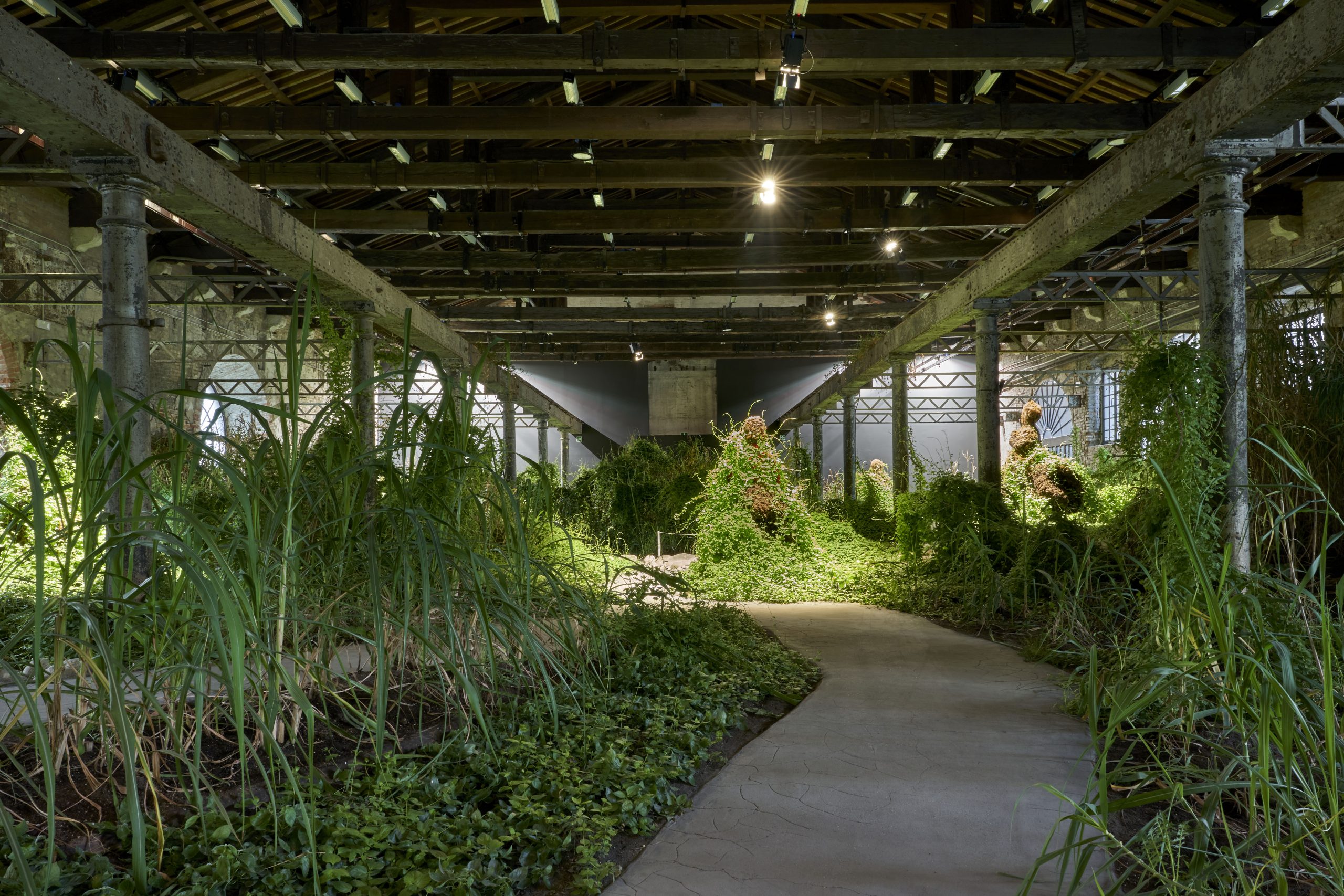Decay is Everywhere: Precious Okoyomon in Conversation with Elvia Wilk
In recent years, artist and poet Precious Okoyomon has made a number of artworks and installations that function as ecosystems, in which materials live and thrive, decay and die. These works approach landscape, topography, and the movement of various species in ways that make clear how the Earth and everything that grows have been marked by histories of colonization and exploitation. Most recently, their major installation, To See the Earth before the End of the World (2022), opened as part of the exhibition The Milk of Dreams, curated by Cecilia Alemani for the 2022 Venice Biennale. Here they talk with writer Elvia Wilk, who has explored several related themes in her work in fiction and non-fiction writing. Wilk’s new collection, Death by Landscape (2022), brings together several essays that include narrative shifts away from the human and toward the Earth, including the erotics of rot, plant protagonists, and ecosystemic thinking.
– Laura McLean-Ferris, 2022 EIR

Elvia Wilk: During the pandemic, I started working on the compost team at my local community garden. Over the many months of collecting food scraps, shoveling them and mixing them, and watching them decompose, I became rapturous about the magic of dirt! While thinking through your many exhibitions and projects over recent years, I couldn’t help but conceive of your methodology in terms of composting. In your living installations, plants thrive and decay, species proliferate and die, and material from one project is recycled and brought into another. Works like Earthseed (2020–2021) at Frankfurt’s Museum für Moderne Kunst and Every Earthly Morning the Sky’s Light touches Ur Life is Unprecedented in its Beauty (2022) at Aspen Art Museum are literally gardens. How do you embrace decay and dissolution when asked to create a piece for an institution, which is often thought of as a static space? Is there an ongoing process of rot and regeneration in your practice?
Precious Okoyomon: Decay is everywhere, it’s the matrixial source code of our always already non-agential world. In the West, culturally, politically, economically, etc., there’s an extraordinarily elaborate sociogenic denial of this raw material feature of reality. I don’t think of the work as being interested in embracing the possibilities of rot as phenomenon, so to speak, which appears to me everywhere and as entirely inexorable with being itself. Instead I am just experimenting with unthinking this mass invisibility of decomposition. Soft death rot song, everything is flowing in and out of each other. I’m trying to dream my way out of the human, I mean outside of this immense historical rupture that is whiteness and this concept of Man. I mean I want a new ontology … without a redescription of the human outside the terms of our present descriptive statement of the human, Man, and its over-representation outside the terms of the “natural organism.” I’m like, Blackness is the nonmoving earth and the human has nothing left for us: the human can only reproduce the same thing it always already has. We need a new modality of being.
The commission for the Aspen Art Museum was totally unique. That’s a garden. But for exhibitions like Earthseed at the MMK, or this most recent project for the Venice Biennale, although I am working with plant life, I never think of what I am doing in terms of a garden, or gardening. The interventions are artworks—both in their totality as installations, like worlds, and in their individual components. Part of what was special about the Aspen project was the long duration. It’s been open for more than a year now already and will remain up through the summer, which means that, unlike any other exhibition I have done, I got to experiment with actually building soil, putting time and love into it, and enriching it. When the project ends, that soil is going to go back into the community for people to use and it will continue changing over time. There’s obviously a huge amount of organic matter and physical resources that go into the artworks that I make, not to mention the dedicated care they require to sustain themselves, so whenever and wherever possible I have always found ways to donate what’s left of an exhibition after it ends. The trees from the sculptures I made for one of my first shows at the LUMA Westbau in Zurich were planted in schools around Switzerland, for example. But that’s not something I really talk about—it’s not an important part of the work, it’s just a natural extension of a daily practice of ecological listening and material redistribution.

For Earthseed, you filled the space with living kudzu plants—which are deemed an invasive species in the USA. But in your show, the kudzu created its own ecologies, as other species like crickets and snails began to thrive. The title of the show is borrowed from the name of a religion that the main character in Octavia Butler’s Parable of the Sower series invents. Its central tenet is: God is Change. Those books take place after a social and environmental cataclysm, and the characters have to build a new world to live in. They try and fail, flourish and fall apart, start over again and again. If art is a practice of world-building, what belief systems are inherent in your work? Is Butler’s concept that change is the only constant applicable? Are we living before a cataclysm, in the midst of it, after it…?
It’s like a breath relation with everyone you’re with all around. I mean for me, worldbuilding doesn’t have to be this huge thing: it’s soft everyday change. It’s you know this world is always already over, every day in small ways you build bridges with people you love, make new languages to get us to whatever the other side of whatever is coming and is already here.
Kudzu is a recurring element in your work. I love your inversion of the idea of an “invasion” from the “outside” space of the gallery—which is suggestive of other types of inside/outside, native/foreign distinctions. And these distinctions have deep roots in violence. Kudzu was only able to run rampant in the American South because the soil had been destroyed by cotton farming during the Antebellum Period. That certain species are deemed dangerous while others are deemed safe or desirable is a line that reflects other biases and fears, showing how attempts at protecting the natural environment are often based on concepts of purity states to “return” to. Are we in such a state of mixed-upness that we have to embrace the confluence of natural and artificial and allow new ecologies beyond those terms to evolve? (In the gallery and in the forest?)
Destroy the part of you that fetishizes purity! That is pure! Embrace the chaos of our trembling new ecologies, we are in an entangled state of being. Nothing is separated, we have to learn to flow, and form new ecologies, new economies, a new copoiesis!

When I first saw your show at Performance Space New York, Fragmented Body Perceptions as Higher Vibration Frequencies to God, in 2021, I wanted to touch every part with my hands, taste it and drink from it. A snowblower scattered the ash of burned kudzu vines (smuggled in from Frankfurt) over a landscape of rocks and soil, which cradled a stream swimming with fish. It was the first exhibition I had seen in a long time because of the pandemic, and I felt both elated and sorrowful in the space. The growth was generative, but the landscape was also distinctly apocalyptic. It reminds me of something you wrote in a poem: “Bliss hovering over the void.” Did you think of that installation as a space of mourning?
My dog, Rainbow, whom I loved, had just died like a month or two before that show opened. That was really, really hard. I think I felt lost for a lot of that year; even before Rainbow passed, I felt really unsure of that show. I didn’t know what good it could do. There had been so much loss, and it felt like the only thing available or at all worthwhile was to try to grieve. Earthseed had just closed at the MMK, after being postponed for like a year because of the lockdowns. But during that time, the kudzu vines in the show—which had basically just sat in the closed museum for months and months—grew more than we could have ever imagined. So I got this idea to incinerate the vines, which was a way of thinking through mourning, through death. It was just about the same time that Rainbow became ash. Everything was dying and becoming ash, and we were living through that in this blustering storm of death and ash and it was somehow beautiful, like rain. That’s what that piece was about. I guess I am happy to hear you liked that show, I think a lot of people thought it was stupid or heavy-handed or didn’t directly engage with public catastrophe and the protests erupting around it. But for me, it was very personal. I met an older woman in the exhibition one day, she was crying. Her husband had died of the virus. She told me she had gone through her life for months with no space or time for her to just break down, and in the exhibition, with really nothing in front of her requiring something of her, she just cried.
Much of your work is language-based: you write, read aloud, and have staged plays. You’ve said that every work starts with a poem—and that your installations feel like poems themselves. Could you talk about the tension between (what is often thought of as) the closed space of the poem on a page versus the open space of its performance or instantiation in space? Unpredictable things happen during readings, performances, and installations involving other people and species. Are poems likewise meant to live and evolve, mutate and change?
You know, it’s actually strange. I have been working on this book But Did U Die? for like five years now or more, since before I moved to New York after college, and anyway it’s finally going to be published sometime this summer. Most of the poems in the book I finished during those first couple years of writing. But because of all the delays in the publication timeline, I ended up getting to sit with the poems for so much longer than I would have ever hoped, and every time I did a lecture or a performance I got the chance to look at the poems again, to read over them and move things around, make little changes. So part of what’s weird about just now finally setting the poems down in print is that they have been alive with me for so long, growing and then being cut back, a lot of rearrangement. It’s felt really different from what I guess you would regularly just call the editing process, partly because it’s been prolonged for so long and partly because the changes that I have been making to the poems feel really specific to the time and place where they are made, these moments when I am making revisions specifically in response to the context where I know I am going to get to perform them.
So in a way, it feels a bit more like renewal, like I am replenishing the poem. I have loved that. And I’ll definitely keep doing that after the book gets published. Some of these poems have already been published in other places anyway, just not all together in one space, and that hasn’t affected whether I take a moment to look at them again every time I decide to bring one out. And then there’s also all of the changes that happen when I am reading, either just because of being nervous or because of something in the energy of the room or the audience. A lot of times something wild happens and I get to remix as I am actually reading. That’s the other half really of what’s been so weird and magical about this whole situation: you know, being a poet, or well let’s say just a person who thinks of themselves and what they make primarily in terms of poetry, but for so long not having a place like a book where people can go and read what really constitutes such a significant portion of what I think of as my work. It’s work which by all accounts is made just out of language and intended to be written down, but that nevertheless has been able to spill out into the world on all of these different occasions when I do readings and performances.
I love this idea that so many people have gotten to know me as a poet but haven’t been able to go back and really read my poems on the page yet. I wonder what that’s going to be like. The encounters people have with the poems when I read them aloud are far less mediated, more direct, and then they disappear, which I love. But as much as I love hearing them performed, the poems are written for the page and there’s so much that I get to do with them there that you actually can’t see when I read them. Of course, that’s part of why I think reading them is so fun for me. I get to try to vocalize all of the non-linguistic formal things that are going on in the text with my body and with my breath. I love that, too. I mean, in a way, this was what my play The End of the World (2019) came out of. That was a long time ago now, but it was a major piece for me that helped me understand how to bring poetry into an artwork or into a space or institution built to deal with artworks. I did it for the Serpentine Galleries as a Park Night with the curator Claude Adjil and it was the first time I had actors memorizing my poetry and performing it back to me, letting the words live inside them, which was another exercise for me in the vitality of language.

You have work in the current Venice Biennale, which I’ve seen pictures of but haven’t visited yet. What’s the space you installed in like? Curator Cecilia Alemani said she wanted the exhibition to “challenge the figure of men as the center of the universe.” Have you taken up this proposition in a direct way?
The space is called the Artgliere, and it’s this massive room at the end of the Arsenale that was built to store a 1930s destroyer, a battleship in Mussolini’s naval fleet. The installation’s title comes from this incredible Ed Roberson poem, “To See the Earth Before the End of the World.” In it there are six sculptures each made out of raw wool, dirt, and blood bound together with yarn. The sculptures are about life-size. They are deities, or angels. The room has been filled with soil and planted with kudzu and sugarcane, a crop cultivated throughout the world that, like kudzu, originally comes from Asia and made its way across the globe along colonial trade routes. It’s my first time working with sugarcane, which I am really excited about because I’ve wanted to start using it for a really long time. The installation as a whole is very much inspired by Edouard Glissant’s Monsieur Toussaint, a play about revolt and revolution and also about sugarcane, its economy, its history, and its extraordinary ecological autonomy. The experience you have being in the space is choreographed by a musical composition arranged by Gio Escobar of Standing in The Corner, one of my favorite musicians, a time traveler and an astronaut whom I have been very privileged to be able to work with on a few projects now. And then there are butterflies, big enormous black swallowtails like bats that will live, die, and reproduce inside the room. Their lifespan is shorter than ours, so we will get to see all of this many times over. The butterflies form an artwork called The Sky Is Always Black Fort Mose. Fort Mose was an eighteenth-century settlement in Florida of freed Black runaway slaves who escaped south to what was at the time a Spanish colony. I guess the entire work is about the Blackness of the earth. But a lot of times when I look at that, Blackness, in my work I am looking at the actual entanglement of the social fiction of race with living and nonliving things. It’s based in research, but with the butterflies it’s something almost different. It’s just their flight, their beautiful flight, constant. This is Blackness as the earth.
Elvia Wilk is a writer and editor living in New York. Her work has appeared in publications like The New York Review of Books, Frieze, Artforum, Bookforum, Granta, The Atlantic, n+1, The White Review, BOMB, and 4Columns. Her first novel, Oval, was published in 2019, and an essay collection called Death by Landscape is forthcoming in July 2022.